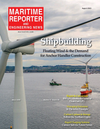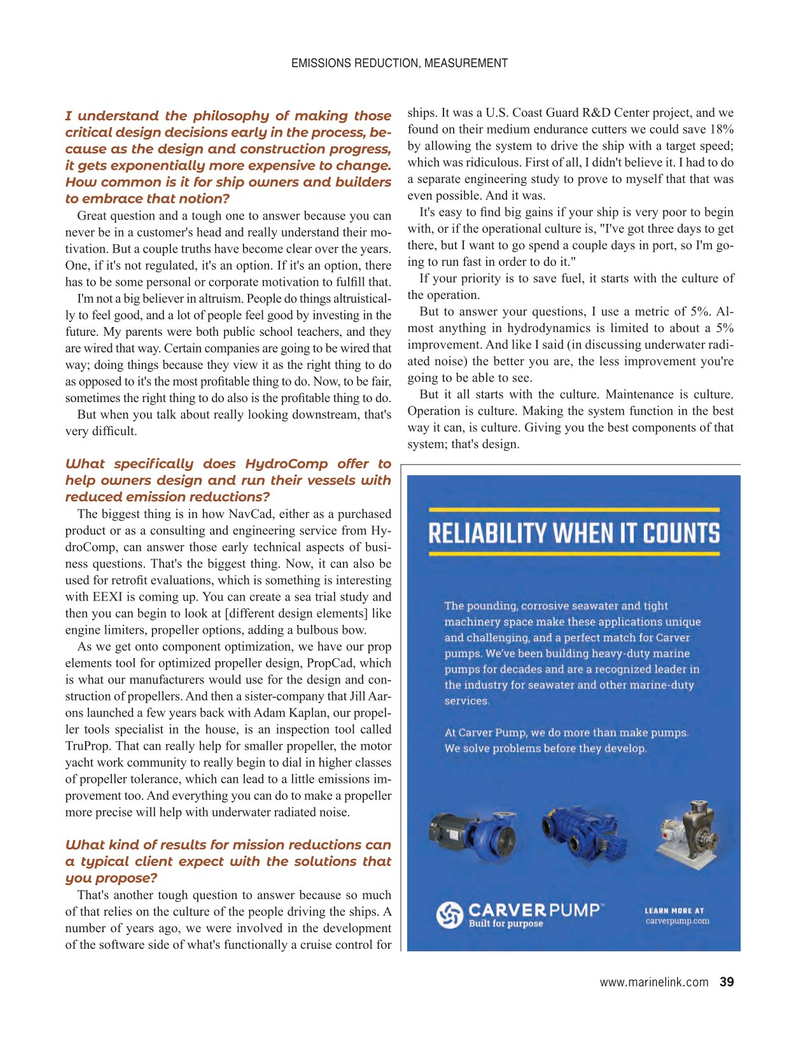
Page 39: of Maritime Reporter Magazine (August 2023)
Shipyard Annual
Read this page in Pdf, Flash or Html5 edition of August 2023 Maritime Reporter Magazine
EMISSIONS REDUCTION, MEASUREMENT
I understand the philosophy of making those ships. It was a U.S. Coast Guard R&D Center project, and we found on their medium endurance cutters we could save 18% critical design decisions early in the process, be- cause as the design and construction progress, by allowing the system to drive the ship with a target speed; it gets exponentially more expensive to change. which was ridiculous. First of all, I didn't believe it. I had to do
How common is it for ship owners and builders a separate engineering study to prove to myself that that was even possible. And it was. to embrace that notion?
It's easy to ? nd big gains if your ship is very poor to begin
Great question and a tough one to answer because you can with, or if the operational culture is, "I've got three days to get never be in a customer's head and really understand their mo- there, but I want to go spend a couple days in port, so I'm go- tivation. But a couple truths have become clear over the years.
One, if it's not regulated, it's an option. If it's an option, there ing to run fast in order to do it."
If your priority is to save fuel, it starts with the culture of has to be some personal or corporate motivation to ful? ll that. the operation.
I'm not a big believer in altruism. People do things altruistical-
But to answer your questions, I use a metric of 5%. Al- ly to feel good, and a lot of people feel good by investing in the future. My parents were both public school teachers, and they most anything in hydrodynamics is limited to about a 5% improvement. And like I said (in discussing underwater radi- are wired that way. Certain companies are going to be wired that way; doing things because they view it as the right thing to do ated noise) the better you are, the less improvement you're going to be able to see. as opposed to it's the most pro? table thing to do. Now, to be fair,
But it all starts with the culture. Maintenance is culture. sometimes the right thing to do also is the pro? table thing to do.
But when you talk about really looking downstream, that's Operation is culture. Making the system function in the best way it can, is culture. Giving you the best components of that very dif? cult. system; that's design.
What speci? cally does HydroComp offer to help owners design and run their vessels with reduced emission reductions?
The biggest thing is in how NavCad, either as a purchased product or as a consulting and engineering service from Hy- droComp, can answer those early technical aspects of busi- ness questions. That's the biggest thing. Now, it can also be used for retro? t evaluations, which is something is interesting with EEXI is coming up. You can create a sea trial study and then you can begin to look at [different design elements] like engine limiters, propeller options, adding a bulbous bow.
As we get onto component optimization, we have our prop elements tool for optimized propeller design, PropCad, which is what our manufacturers would use for the design and con- struction of propellers. And then a sister-company that Jill Aar- ons launched a few years back with Adam Kaplan, our propel- ler tools specialist in the house, is an inspection tool called
TruProp. That can really help for smaller propeller, the motor yacht work community to really begin to dial in higher classes of propeller tolerance, which can lead to a little emissions im- provement too. And everything you can do to make a propeller more precise will help with underwater radiated noise.
What kind of results for mission reductions can a typical client expect with the solutions that you propose?
That's another tough question to answer because so much of that relies on the culture of the people driving the ships. A number of years ago, we were involved in the development of the software side of what's functionally a cruise control for www.marinelink.com 39
MR #8 (34-49).indd 39 8/3/2023 2:48:36 PM

 38
38

 40
40
